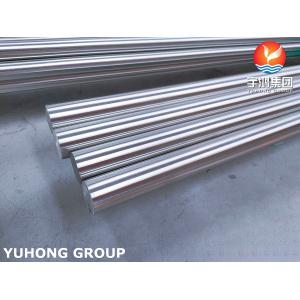
Add to Cart
ASTM A276 316L UNS S31600 Stainless Steel Round Bar Rod Chemical Bright Annealed
1.4401 stainless steel is a commonly used stainless steel material, also known as AISI 316 or ASTM A276 Type 316. It has excellent corrosion resistance and mechanical properties, suitable for various industrial fields. This article will provide a detailed introduction to the chemical composition, hardness, density, heat treatment, mechanical properties, mechanical properties, application areas, and welding process of this material.
Chemical composition
The chemical composition of 1.4401 stainless steel includes: maximum carbon (C) content of 0.07%, maximum silicon (Si) content of 1.0%, maximum manganese (Mn) content of 2.0%, maximum phosphorus (P) content of 0.045%, maximum sulfur (S) content of 0.03%, chromium (Cr) content of 16.5-18.5%, nickel (Ni) content of 10.0-13.0%, and molybdenum (Mo) content of 2.0-2.5%.
Hardness
The hardness of 1.4401 stainless steel under annealing conditions is HB ≤ 215.
Density
The density of 1.4401 stainless steel is approximately 7.99g/cm ³.
Heat treatment
1.4401 stainless steel can be heat treated through solution treatment and cooling to improve its hardness and strength.
Mechanical properties
The tensile strength of 1.4401 stainless steel is ≥ 520 MPa, yield strength is ≥ 205 MPa, elongation is ≥ 40%, and elastic modulus is about 200 GPa.
Mechanical performance
1.4401 stainless steel has good corrosion resistance and processing performance, and can be used for manufacturing chemical equipment, food processing equipment, medical devices, etc.
Application field
1.4401 stainless steel is widely used in chemical industry, pharmacy, food processing, shipbuilding, medical equipment and other fields, especially in the environment with high requirements for corrosion resistance.
Welding process
1.4401 stainless steel is suitable for conventional welding methods such as arc welding, gas shielded welding, etc., but attention should be paid to controlling welding heat input and avoiding overheating to maintain its corrosion resistance.
In summary, 1.4401 stainless steel has excellent corrosion resistance and mechanical properties, making it suitable for manufacturing and processing in multiple fields. Understanding its chemical composition, hardness, density, heat treatment, mechanical properties, mechanical properties, application fields, and welding processes is of great significance for the correct selection and application of this material.
Stainless Steel 316l Round Bar Mechanical Properties
| Element | SS 316L |
| Density | 8.0 g/cm3 |
| Melting Point | 1400 °C (2550 °F) |
| Tensile Strength | 485 Min |
| Yield Strength (0.2%Offset) | 170 Min. |
| Elongation | 40% Min |
| Hardness (Brinell) | 217 Max. |
Stainless Steel Bar Specifications
| ASTM A276 | This specification encompasses cold-finished or hot-finished bars, including rounds, squares, and hexagons, and hot-rolled or extruded shapes, such as angles, tees, and channels in the more commonly used types of stainless steels. |
| ASTM A479 | This specification includes cold and hot finished stainless steel bars, including rounds, squares, and hexagons, and hot-rolled or extruded shapes such as angles, tees, and channels. |
| ASTM A484 | This specification includes wrought stainless steel bars, shapes, forgings, and billets or other semi-finished materials, except wire, for forging. The materials are available in four types of conditions. |
| ASTM A582 | This specification includes cold or hot finished bars, which are suitable for machining processes. This specification includes rounds, squares, and hexagons, from common types of stainless free-machining steels. |
| ASTM B473 | This specification includes nickel alloy bar & wire, which can be produced in a solution-annealed condition, stabilized-annealed condition, or annealed condition. |
